By: debbie lynn elias
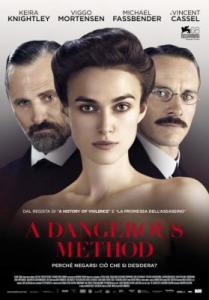
Michael Fassbender dominates the movie screens this week with two superb films – A DANGEROUS METHOD and Shame. Walking a fine line of social and moral acceptability with both characters crossing lines, pushing the envelope and addressing highly charged issues of sexual dysfunction, sex scenes are graphic in both and in the NC-17 rated Shame, Fassbender bares it all with full frontal nudity. Both are superb with performances and direction that could garner further award attention. Each is fascinating subject matter and you will find yourself engrossed in the stories and the characters. But here, I turn my attention to A DANGEROUS METHOD. Helmed by award winning director David Cronenberg, this is based on the true story of psychiatrists, Carl Jung and Sigmund Freud, and Jung’s patient Sabina Spielrein.?xml:namespace prefix = o ns = “urn:schemas-microsoft-com:office:office” /
As soon as this film ended, I wanted to see more. One of the most fascinating character studies I have ever seen, although we know how the lives of each of our principals, and the world, evolved, A DANGEROUS METHOD is so compelling, one can’t help but crave wanting to see everything unfold for oneself.
Set in the early 1900’s on the eve of WWI in a tumultuous political climate, A DANGEROUS METHOD is the story of another upheaval taking place in the world; that in the world of psychiatry. While darkness was falling for many thanks to impending war, for others, there was enlightenment, discovery and hope thanks to an experimental treatment known as “the talking cure” or psychoanalysis. Developed by Sigmund Freud, this treatment was groundbreaking and controversial. Until this time, people with “mental” afflictions were treated with pastoral settings, waterfalls, brooks, rills, lush green forests, lulling tones of music, peaceful surroundings. But they had no one listening to them. As related by director David Cronenberg, “Here was Freud saying, ‘Listen to them because they will tell you what’s wrong with them. And they will tell you how to cure them.’” A devotee of this method was none other than psychiatrist Carl Jung.
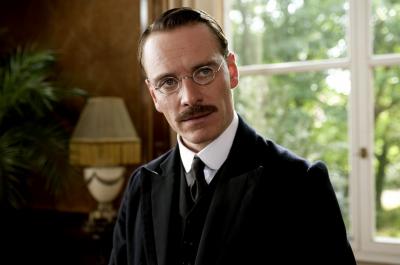
At the beginning of his career, Jung is living in Zurich, working at Burgholzi Hospital. Anxious to try Freud’s treatment, of which he had only so far only read about, he is presented with patient Sabina Spielrein. A well-educated Russian who speaks fluent German, Sabina has been diagnosed with “hysteria” and dumped on Jung’s doorstep by her parents. As part of her condition, Sabina becomes violent, her body becomes contortive with speech difficult to impossible due to muscle tensing.
Electing to treat Sabina with Freud’s remarkable talking cure, he corresponds with Freud discussing the case and the slow, but successful progress of the method. (So successful is the treatment that eventually Sabina herself would become a psychiatrist and a “protégée” of Freud.) It is through this correspondence that Jung and Freud strike what would become a long term friendship. Similarly, as Jung delves ever deeper into Sabina’s psyche (and heart) and uncovers the genesis of her problems and the disturbing sexual elements to her dysfunction, the relationship between Sabina and Jung intensifies, so much so that in what may be the first documented violation of the doctor/patient relationship in a psychiatric setting, Jung crosses all boundaries and begins an affair with Sabina.

But what happens when the relationship amongst Freud, Jung and Spielrein turns into a psychological menages-a-trois with lies, deceit and guilt consuming Jung?
Brilliant enigmatic dichotomous performances by Keira Knightley and Michael Fassbender as each walks the line of sanity, while seeking and trying to understand it, but in very different ways. As Carl Jung, Fassbender exhibits such buttoned down control, primness, propriety, stick-up-his-butt reserve and does so with such a ferocity, that he remains true to the character of Jung even in the heat of masochistic sexual liaisons with Knightley’s Sabina. He maintains a firm controlled resistence, never allowing one to see Jung either achieve or receive pleasure, always presenting a silent aura of being a scientist, studying. He is methodical, precise and meticulous in his movements, diction, elocution, manners. Appealing to Fassbender about portraying Jung is the “conflict. . . I think what we do is heightened reality. It’s like people go, “It’s not real.” Well, real can be really boring. It’s like we’re trying to ask questions and seek out drama and the best way to have that is to have conflict. Conflict between characters or conflict within the character itself. I think it just makes it for more interesting viewing and it’s more provocative and makes us question things a bit more. . . I’m not like ‘here’s the villain – here’s the good guy’ which is kind of just boring for me. It’s like, ‘what happens if you grow the two together.’” Here, we have a character rooted in reality and fact that is perhaps, the essence of conflict.

As Sabina, Keira Knightley, with contortionistic facial movements and wild-eyed expressiveness so necessary to the character as the physical manifestations of her psychological trauma, just commands the screen. Working closely with Cronenberg to achieve and execute an exacting portrayal, Cronenberg analyzes the creation of these physical nuances within the character. “I said to Keira, ‘As in other cases with these patients, [the movement] should all be around your mouth and jaw. You’re trying to deform the words so they’re not understandable at all.’ You can talk to [Keira] about these abstract things and she can find a way to embody it. That’s her brilliance as an actress.” Notable for Cronenberg in Knightley’s performance is that even as Sabina becomes a professional in her own right, “there’s still that volatility, that fragility underneath the surface. It’s a really beautiful performance.” One faux pas by Knightley, however, is with her accent. Generally consistent, there are times when she slips up during her rapid-fire, foaming at the mouth dialogue delivery.
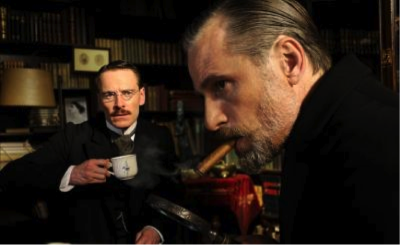
Viggo Mortenson is virtually unrecognizable as Sigmund Freud. With altered facial perceptions and a very different physicality, he is everything one would believe is the essence of Freud. His vocal intonations, however, sounded more like George C. Scott as Patton as opposed to the Viennese doctor. Mortenson and Fassbender have an enigmatic and dynamic chemistry that ebbs and flows with, at times forced restraint, at other times adoration and envy, and at other times, shame and disappointment. It is as interesting to watch these two as it is Fassbender and Knightley. Equally impressive is Vincent Cassel as psychiatrist turned addict, Otto Gross. Sent by Freud to Jung for treatment, Gross is a linchpin in the turn of events amongst the parties. As someone on the outside now looking now, Cassel brings not only an energetic and frenzied aspect to the film, but a grounding and thoughtful positing of the events unfolding. He speaks what the audience is thinking.

Written by Christopher Hampton based on his play The Talking Cure, itself adapted from the book A Most Dangerous Method by John Kerr, director David Cronenberg further empowers the work by drawing on the original source material – the letters between Jung and Freud – giving new layers and insight into the minds and hearts of these men. So personalized and intimate that while watching, one can’t help but feel as if they are in the doctor’s chair and the characters are on the couch, affording the audience an opportunity to turn the tables and psychoanalyze these men.
Beyond the intense almost visually psychoanalytical character studies, the film succeeds in illumination of the ongoing battle of psychiatric treatment and the methods of Freud versus Jung, a battle we not only see explained visually through the individual personas of the characters themselves, thus allowing greater understanding of the two schools of thinking, but through the scripted dialogue and timeline. A great history lesson for those interested in the subject matter. It also serves as a great expression of European social reality contrasted with Freudian theories of human urges and sexuality.
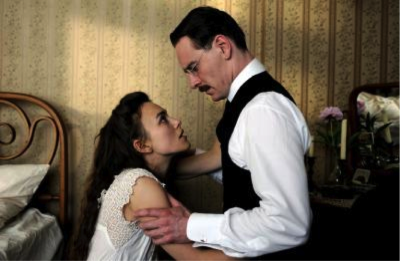
Known for early films that focus on exploration of the body, horrific scientific exploration and abstractness, with A DANGEROUS METHOD, Cronenberg takes the abstractness and volatility of psychoanalysis and these individuals, making them front and center, placing it all under a microscope, making this film voyeuristically fascinating to watch, both visually and emotionally. A standout aspect among the visuals is that involving self-voyeuristic viewing in mirrors, particularly between Jung and Sabina during sex scenes. While there is no factual evidence that this is what actually occurred, Cronenberg’s rationale for this lensing style is more than plausible. “These people were their own first subjects. They felt they had invented A new thing, this psychoanalysis. And the relationship between and analyst and his patient was a brand new relationship that had never existed between humans before. They were experimenting with it. . .At that point the ethical boundaries have not been established and the realities of what that relationship was were not known. They were very obsessive about observing themselves. . .With Sabina, I felt, having plugged in totally to this obsessive psychoanalytic state of mind, would be observing herself, even while she was having sex. She would be observing herself; how she felt, what her reaction was, what Jung’s reaction was – because you see the way we played that. Jung is not really enjoying those moments, he’s doing it for her. And he would be observing it to from a clinical distance. So that was really the reason for that choreography.”
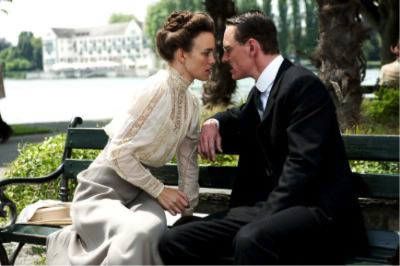
Visually, the film is exquisite. Peter Suschitzky’s cinematography is liberating – expansive, light, bright, metaphoric for the psychoanalytical expanding of the mind; almost representative of a light at the end of the mind’s dark tunnel. Brilliantly designed and lensed. And the beauty of Bodensee as a substitute for Lake Zurich – the serenity, peace, beauty and light of the setting is a wonderful contrast to the darkness of the mind and the tunnel vision that Jung and Freud accused each other of promulgating. Likewise, James McAteer’s production design is meticulous, exacting and serves each character and each scene perfectly. The care and attention to detail that went into this production is both astounding and appreciated.
Dare to face the dangers of the mind with A DANGEROUS METHOD.
Carl Jung – Michael Fassbender
Sigmund Freud – Viggo Mortenson
Sabina Spielrein – Keira Knightley
Otto Gross – Vincent Cassel
Directed by David Cronenberg. Written by Christopher Hampton based on the play The Talking Cure by Hampton and adapted from the book, A Most Dangerous Method by John Kerr.











